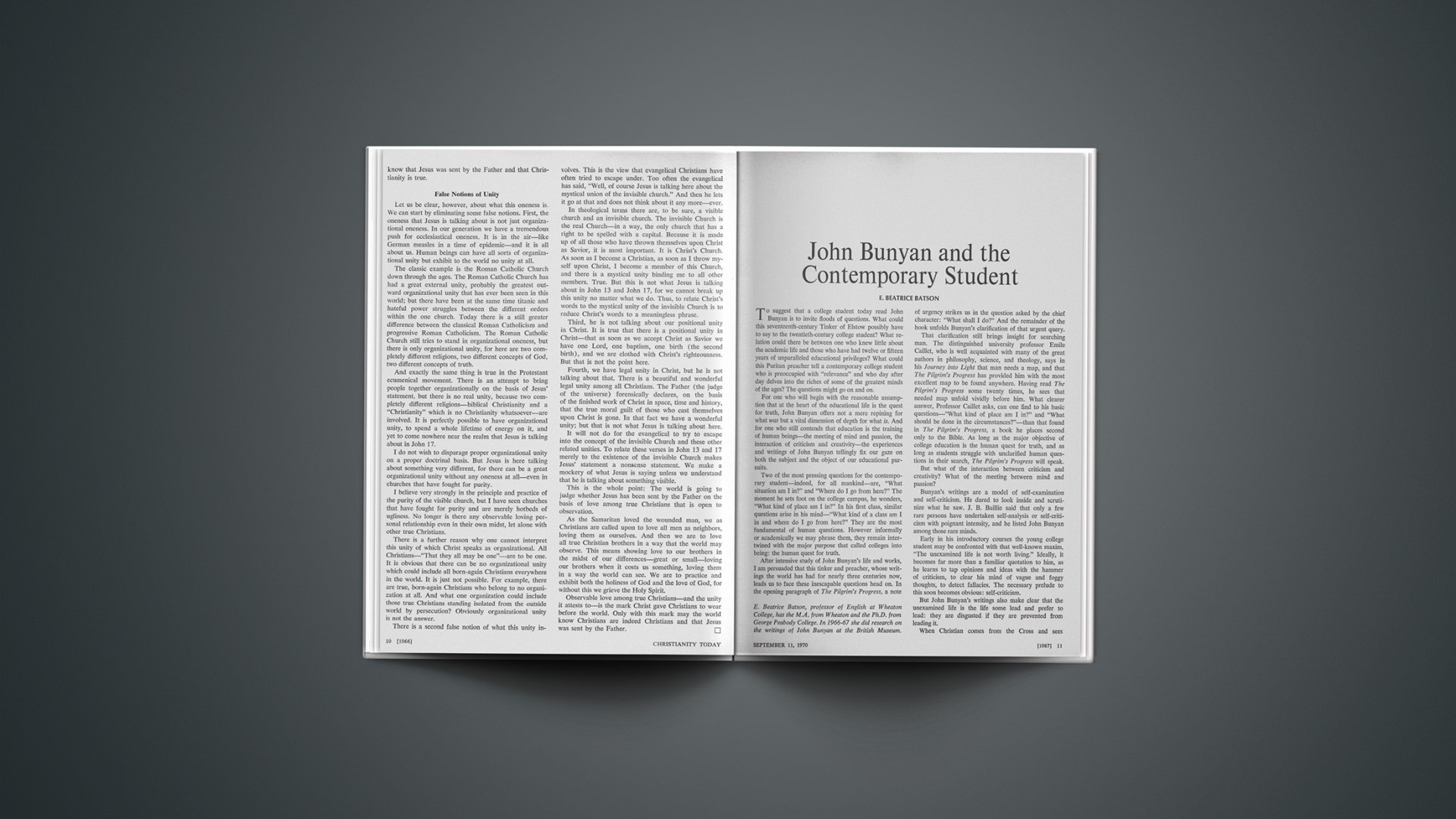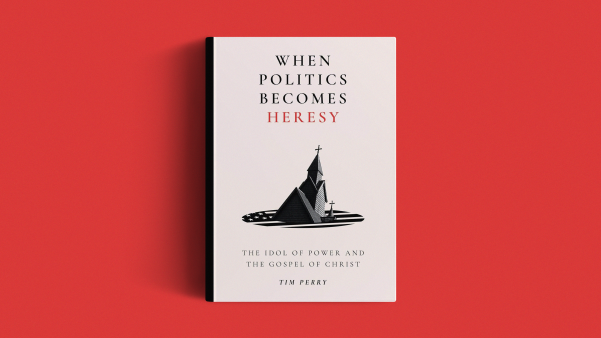To suggest that a college student today read John Bunyan is to invite floods of questions. What could this seventeenth-century Tinker of Elstow possibly have to say to the twentieth-century college student? What relation could there be between one who knew little about the academic life and those who have had twelve or fifteen years of unparalleled educational privileges? What could this Puritan preacher tell a contemporary college student who is preoccupied with “relevance” and who day after day delves into the riches of some of the greatest minds of the ages? The questions might go on and on.
For one who will begin with the reasonable assumption that at the heart of the educational life is the quest for truth, John Bunyan offers not a mere repining for what was but a vital dimension of depth for what is. And for one who still contends that education is the training of human beings—the meeting of mind and passion, the interaction of criticism and creativity—the experiences and writings of John Bunyan tellingly fix our gaze on both the subject and the object of our educational pursuits.
Two of the most pressing questions for the contemporary student—indeed, for all mankind—are, “What situation am I in?” and “Where do I go from here?” The moment he sets foot on the college campus, he wonders, “What kind of place am I in?” In his first class, similar questions arise in his mind—“What kind of a class am I in and where do I go from here?” They are the most fundamental of human questions. However informally or academically we may phrase them, they remain intertwined with the major purpose that called colleges into being: the human quest for truth.
After intensive study of John Bunyan’s life and works, I am persuaded that this tinker and preacher, whose writings the world has had for nearly three centuries now, leads us to face these inescapable questions head on. In the opening paragraph of The Pilgrim’s Progress, a note of urgency strikes us in the question asked by the chief character: “What shall I do?” And the remainder of the book unfolds Bunyan’s clarification of that urgent query.
That clarification still brings insight for searching man. The distinguished university professor Emile Caillet, who is well acquainted with many of the great authors in philosophy, science, and theology, says in his Journey into Light that man needs a map, and that The Pilgrim’s Progress has provided him with the most excellent map to be found anywhere. Having read The Pilgrim’s Progress some twenty times, he sees that needed map unfold vividly before him. What clearer answer, Professor Caillet asks, can one find to his basic questions—“What kind of place am I in?” and “What should be done in the circumstances?”—than that found in The Pilgrim’s Progress, a book he places second only to the Bible. As long as the major objective of college education is the human quest for truth, and as long as students struggle with unclarified human questions in their search, The Pilgrim’s Progress will speak.
But what of the interaction between criticism and creativity? What of the meeting between mind and passion?
Bunyan’s writings are a model of self-examination and self-criticism. He dared to look inside and scrutinize what he saw. J. B. Baillie said that only a few rare persons have undertaken self-analysis or self-criticism with poignant intensity, and he listed John Bunyan among those rare minds.
Early in his introductory courses the young college student may be confronted with that well-known maxim, “The unexamined life is not worth living.” Ideally, it becomes far more than a familiar quotation to him, as he learns to tap opinions and ideas with the hammer of criticism, to clear his mind of vague and foggy thoughts, to detect fallacies. The necessary prelude to this soon becomes obvious: self-criticism.
But John Bunyan’s writings also make clear that the unexamined life is the life some lead and prefer to lead: they are disgusted if they are prevented from leading it.
When Christian comes from the Cross and sees Simple, Sloth, and Presumption fast asleep with fetters upon their heels, he tries to arouse them. Simple lethargically replies, “I see no danger.” As long as he can dwell without interruption within his own mental boundaries, he will not suffer the shock of the fetters upon his heels. Simple can never stand the insecurity of a fresh perspective; an open mind is alien to him. Look at Sloth: his eyes are closed to change and responsibility. Life does not interest or challenge him, and he sleeps his years away. Then there is Presumption. Living by empty, shallow platitudes, he refuses to throw himself into problems demanding hard thinking and discerning action.
John Bunyan knew the Simples, the Sloths, the Presumptions of his day. In some of his closely argued prose works, there is evidence aplenty that he was not shocked by the views of his opponents or carried off his feet by them. Although some of his works are argumentative and heated, he exemplifies a quality of mind that commands respect. In The Greatness of Soul, for example, there is a model of what discussion and interchange should be: searching and precise, candid and open, courteous and calmly reasoned. And this same quality of mind Bunyan brought to bear on a wide variety of subjects, including the social problems of his day. In his treatises as well as in his fiction, there are, for example, intense protests against the cruelty of the rich and the privileged who are indifferent to the plight of the poverty-stricken.
John Bunyan also “speaks” to the student today in his emphasis—both in theory and in practice—upon creativity. When he was about the age of today’s college students, he wanted a musical instrument but was too poor to buy one. And so he set about fashioning a violin. Not knowing how to make it from wood, Bunyan hammered it out from iron on an anvil. So well beaten out was this musical instrument that it bears no trace of the hammer upon it. It is now in the Bunyan museum in Bedford, England.
There is clear evidence of this kind of creative imagination at work in his writings. His primary purpose is widely considered to have been teaching, edifying, sending forth a “coated” sermon. Undeniably, he was interested in the hortatory values of his work, but his concern for the imaginative, artistic, and creative is equally undeniable. In the rhymed preface to The Pilgrim’s Progress he tells of the personal satisfaction writing gave him, of the delightful experience of having thoughts develop and of deciding what form those thoughts should take. He speaks of the legitimacy of writing in the style he had chosen; and in the final section of the rhymed preface, he shows keen perception into the nature of imaginative literature: its nexus of meaning, its tragicomic essence, and its power to evoke response. Bunyan held no impoverished view of literature. He knew its power, in its own unique way, to deepen and enrich man’s understanding of himself and of his greatest need, and he produced creative works that are concrete presentations of human experience.
Bunyan dared to imagine. And for three centuries his works—particularly The Pilgrim’s Progress and Grace Abounding—have captured the imagination of readers from all segments of society. Creativity and criticism interact in this formally untrained but not illiterate seventeenth-century author. And in his pursuit of truth he wrestled with the large, enduring questions of moral value and personal belief. In The Pilgrim’s Progress, for example, Bunyan does not simply imitate or represent a particular person in a particular situation searching for a particular set of beliefs; he handles Christian on his well-marked journey in such a way that he reveals universal qualities, thus illuminating the essential nature of man in his world. He searched deeply enough within his own being to discover something about men of all times: he knew their weaknesses, their imperfection, their wickedness, but also their inner conflicts, their strengths, their aspirations, and their quest for meaning. Combining this perception of man’s nature with a compulsion to tell what he saw and felt, Bunyan selected his theme, ordered it around the details of the moment, and imaginatively created a world that clearly depicts man’s human condition and hope for his salvation.
Chief among the concerns of this restless college generation, it seems to me, is the desire to grapple with the enduring questions of life and to find that truth—not marketability—is the criterion of sound academic pursuit. Life’s fundamental questions are intertwined with the basic objective of college life, and the clarification of these questions calls for a commitment that involves critical insight, creative industry, intelligent effort, and personal belief. So long as students and all men frame fundamental human questions, seek certainty, and find barriers in their quest, the writings of this seventeenth-century tinker will make their strange appeal and remain peculiarly relevant.










